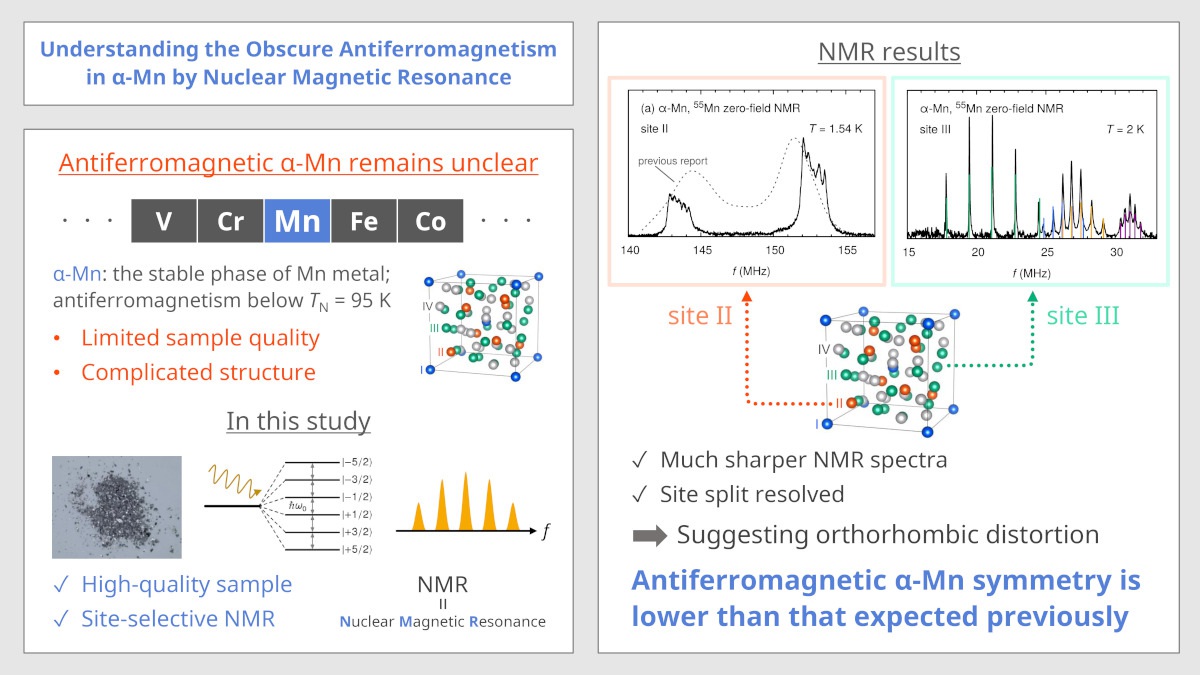Understanding the Obscure Antiferromagnetism in α-Mn by Nuclear Magnetic Resonance
© The Physical Society of Japan
This article is on
Site Split of Antiferromagnetic α-Mn Revealed by 55Mn Nuclear Magnetic Resonance
(JPSJ Editors' Choice)
J. Phys. Soc. Jpn. 91, 113701 (2022).
Although Mn is an elementary metal, the antiferromagnetic state of α-Mn is still obscure. Our NMR study on high-quality α-Mn provides new insights into the symmetry of its antiferromagnetism.

Magnetism in most elementary metals is well understood. An exception is α-Mn, the stable phase of metallic manganese at ambient temperature and pressure. This system crystallizes in a unique structure, wherein four Mn sites exist in a cubic structure with 58 atoms per unit cell. This system exhibits an antiferromagnetic ordering at a Néel temperature of TN = 95 K. In the antiferromagnetic state, all the four sites have magnetic moments. Despite active studies in the 70 years since the discovery of the antiferromagnetism in this system, knowledge regarding the symmetry and the moment directions remains insufficient. It is difficult to precisely clarify the magnetic structure because of the complexity of the crystal and the limited sample quality.
Since the discovery of the pressure-induced magnetic phase at above 1.5 GPa, the magnetism of α-Mn has received renewed attention. This phase shows a large anomalous Hall effect, which is common in ferromagnets. The anomalous Hall effect is closely related with the topological nature of the magnetic properties. The pressure-induced phase is also suppressed using pressure and shows quantum critical behavior at approximately 4.2 GPa. The elementary metal is still useful in condensed matter physics.
We measured a nuclear magnetic resonance (NMR) on a high-quality α-Mn sample and obtained a new insight into the magnetic structure. The NMR technique is a useful method for resolving the magnetic information of each site in a crystal. First, it was confirmed that site II split into two sites in the antiferromagnetic state, as previously suggested in the NMR studies. We discovered that each NMR spectrum of Mn-II site shows a fine structure owing to the titling of the magnetic moments with respect to the [001] direction. This shows the non-collinear magnetic structure and nearly parallel moments in the split site II. Furthermore, it was revealed that site III split into four sites below TN, whereas only two III sites were resolved in the previous studies. These findings suggest that α-Mn shows orthorhombic distortion in the antiferromagnetic state, as opposed to the previous expectation that α-Mn orders in the tetragonal one.
The progress in this study is largely owing to the improved sample quality. The present sample was synthesized using the Pb flux method, developed in Okayama University’s group. Further advances in identifying the magnetic structure of α-Mn in both the antiferromagnetic and pressure-induced phases are expected.
(Written by M. Manago on behalf of all the authors.)
Site Split of Antiferromagnetic α-Mn Revealed by 55Mn Nuclear Magnetic Resonance
(JPSJ Editors' Choice)
J. Phys. Soc. Jpn. 91, 113701 (2022).
Share this topic
Fields
Related Articles
-
Antiferromagnetism Induces Dissipationless Transverse Conductivity
Electronic transport in condensed matter
Magnetic properties in condensed matter
Electronic structure and electrical properties of surfaces and nanostructures
2024-7-24
An investigation using high-quality NbMnP crystals demonstrates that the anomalous Hall conductivity arising from antiferromagnetism is dissipationless, as expected from the intrinsic mechanism.
-
Structural Rotation and Falsely Chiral Antiferromagnetism: A New Combination Generating Ferrotoroidic State
Magnetic properties in condensed matter
Dielectric, optical, and other properties in condensed matter
2024-7-4
The ferrotoroidic state, an exotic state of matter with broken space inversion and time-reversal symmetries, was achieved by combining structural rotation and falsely chiral antiferromagnetism in PbMn2Ni6Te3O18.
-
Understanding Electronic Ordering and Cross Correlations with Multipole Representation
Magnetic properties in condensed matter
2024-6-12
This study reviews the recent advancements in research of multipole representations for understanding electronic orderings and cross-correlations in materials and presents future research directions.
-
Microscopic Exploration of Electronic States in Nickelate Superconductors
Magnetic properties in condensed matter
Superconductivity
2024-5-31
The multilayered nickelates, La3Ni2O7 and La4Ni3O10 , were investigated using nuclear magnetic resonance (NMR) at ambient pressure. Metallic electronic states under the density wave order were observed microscopically for both compounds.
-
Solving a Stochastic Differential Equation is Solving a Mean-Field Quantum Spin System
Statistical physics and thermodynamics
Mathematical methods, classical and quantum physics, relativity, gravitation, numerical simulation, computational modeling
Magnetic properties in condensed matter
2024-5-16
The replica method maps matrix-valued geometric Brownian motion to a mean-field quantum spin system. This correspondence makes it possible to obtain an exact solution for matrix-valued geometric Brownian motion.
